Birds of prey, or raptors, are carnivorous birds that hunt and kill prey using a combination of their keen senses, strong talons and sharp, hooked beaks. Ranging from the minuscule falconet to the colossal Andean condor, birds of prey have ruled the skies since the extinction of the dinosaurs.
Buzzards, falcons, vultures, hawks, kites, eagles, harriers, owls and osprey are all examples of birds of prey. The Secretary Bird and Seriemas are also birds of prey but are considered to be somewhat outliers of the main groups.
The UK is home to some 15 species of birds of prey, covering every group aside from vultures.
From the epic Golden and White-Tailed eagle to the mighty Merlin, this is a guide to birds of prey in the UK.
The Most Common Birds of Prey in the UK
The British birds of prey below are generally the most likely ones you're going to spot in the UK (location dependant).
Buzzard
Buteo buteo
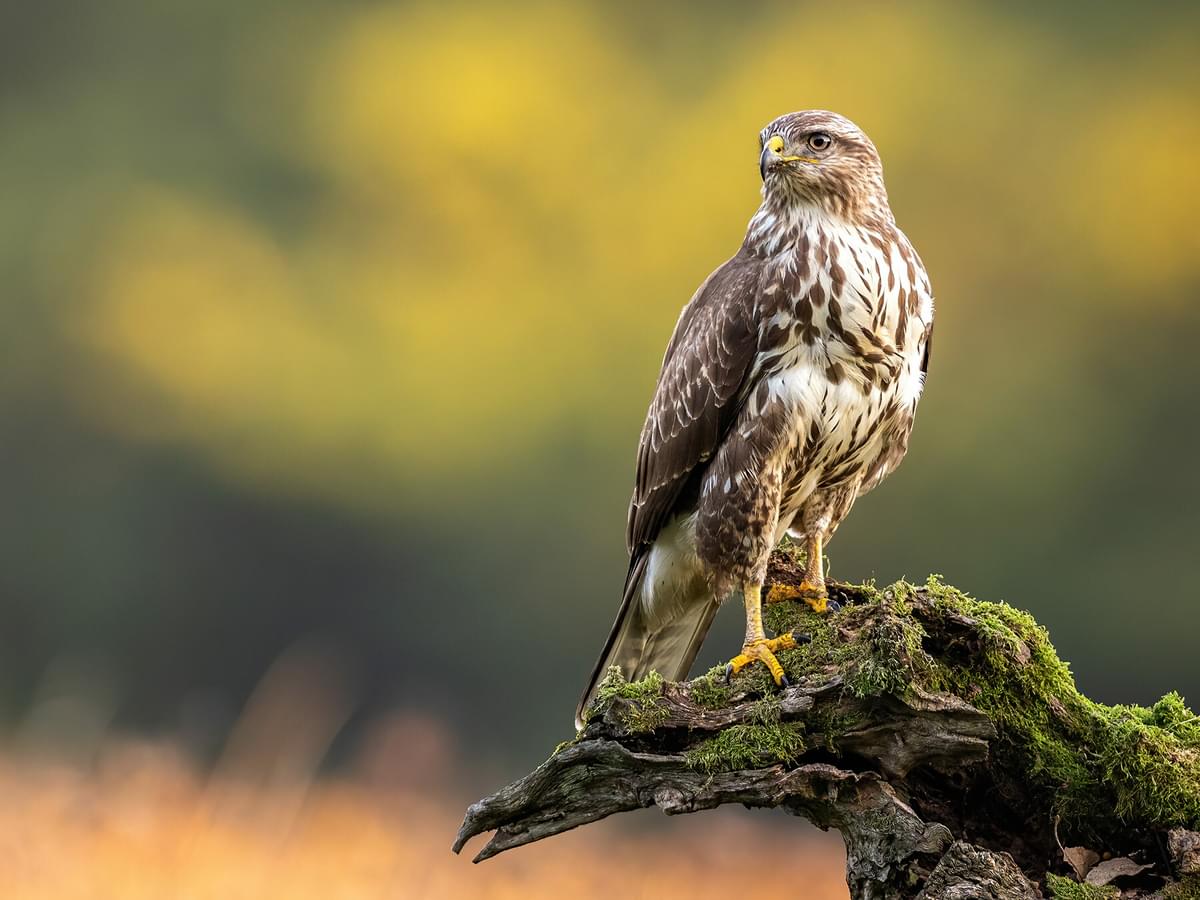
Length
51-57cm
Wingspan
113-128cm
Weight
550-1200g
Regional Rarity Score
Ranges from 0 (common) to 100 (extremely rare) in this region
The Common buzzard is the UK’s most abundant bird of prey. While they’re most common in Wales, Scotland, the Lake District, South West England and much of Northern Ireland, the Common buzzard now inhabits practically every part of the UK.
The Common buzzard lives mainly in dense woodland, scrub, moorland, farmland and rural villages, but they’re now even seen in Glasgow and other Scottish cities.
Buzzards are a success story in the UK, as they were all but extinct in the 1900s, with fewer than 1,000 pairs remaining. Today, there are more than 100,000 pairs, and they’re among the few birds of prey in the UK whose numbers are continually increasing.
Appearance
Common buzzards are large, measuring around 40 to 60cm long with a wingspan of 113 to 128cm, and are typically brown with white undersides. However, their appearance varies in what are called ‘morphs’ - some are light, almost white, whereas others are black or even reddish.
Red Kite
Milvus milvus
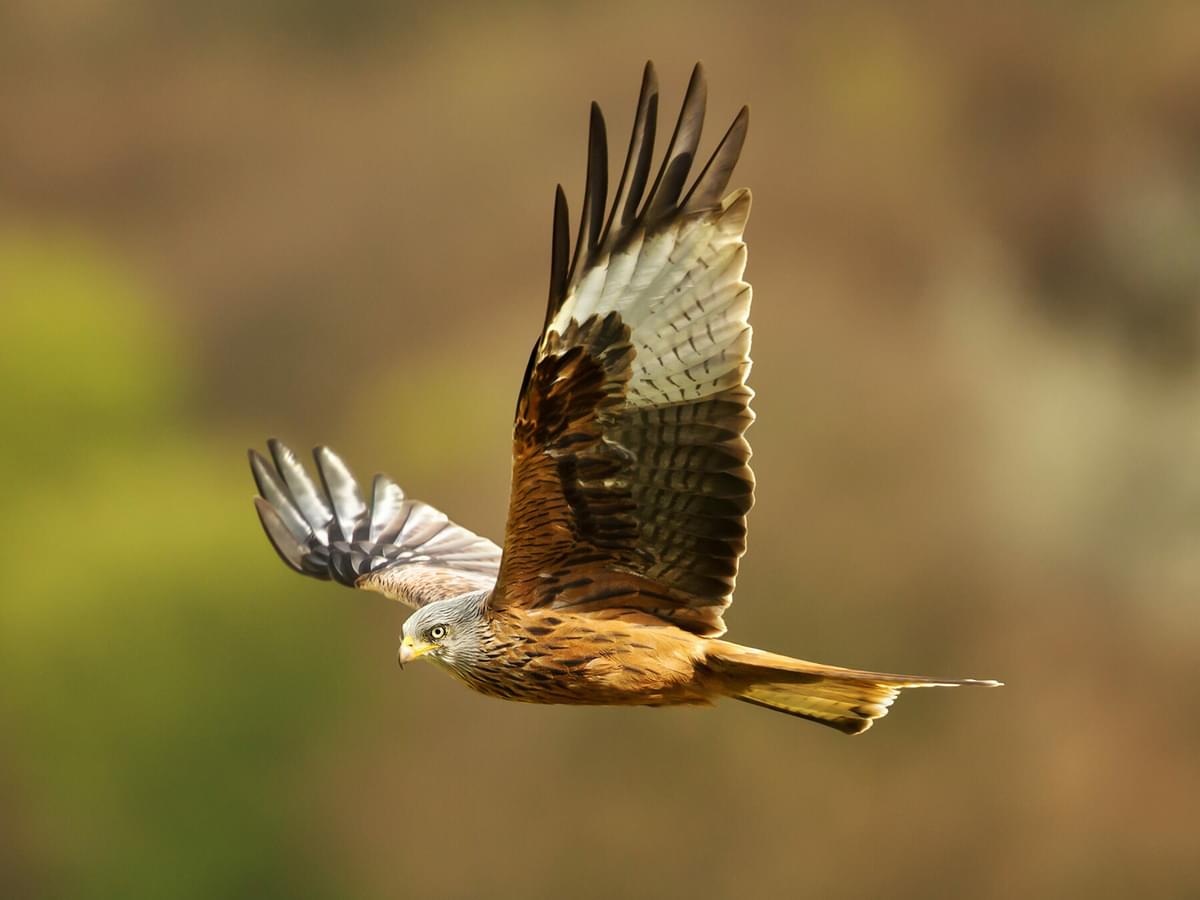
Length
60-66cm
Wingspan
145-165cm
Weight
800-1300g
Regional Rarity Score
Ranges from 0 (common) to 100 (extremely rare) in this region
Red kites are the UK’s largest common birds of prey, with an impressive wingspan of 175 to 185cm. Famed for their graceful hovering flight and playful and gregarious nature, Red kites are a conservation success story.
In much of the 20th century, Red kites were heavily persecuted for their eggs and became confined to small parts of Wales. They were reintroduced to the Chilterns, East Midlands, Yorkshire and other parts of northern England throughout the 1990s and are now thriving across virtually all of the UK. For example, in 1990, 13 Red kites were released in the Chilterns, and as of 2020, there are probably some 4,000 breeding pairs. These graceful, imposing raptors are now a common sight over both urban and rural areas.
Appearance
Red kites are exceptionally large birds, measuring some 60 to 70cm on average with a wingspan of 175 to 185cm, and have a reddish-brown body and broad, white-tipped wings and large forked tail.
They have a white-brown head and a large, hooked bill. While they do hunt small mammals, Red kites generally prefer to take carrion by hovering and swooping in to grasp it with their talons. Seeing groups of 5 to 20 Red kites encircling carrion is not uncommon.
Sparrowhawk
Accipiter nisus

Length
28-38cm
Wingspan
55-80cm
Weight
110-340g
Regional Rarity Score
Ranges from 0 (common) to 100 (extremely rare) in this region
Small but deadly, the Sparrowhawk is a small to medium-sized bird of prey from the Accipiter family. The female is as much as 25% bigger than the male - the size difference is so significant that females have a more diverse diet than males as they’re able to catch a wider range of prey.
Sparrowhawk numbers crashed during the late 20th century, mainly due to poisoning from organochlorine pesticides. Their numbers have increased dramatically, and they’re found all throughout the UK except the Scottish Highlands, but recent surveys have shown that Sparrowhawk populations are starting to fall again. For conservationists, boosting the Sparrowhawk population is a risky endeavour as they’re very efficient at hunting and killing small birds and negatively impact songbird populations.
Appearance
Measuring some 30 to 45cm and with a wingspan of some 50 to 80cm, Sparrowhawks have short, broad wings and a long tail, which aid them in manoeuvring tight corners around trees and hedgerows. They’re mostly slate-grey with light brown upperparts and wings, which also have a red-orange tinge around the breast and body. Sparrowhawks have large, bright yellow-orange eyes.
Kestrel
Falco tinnunculus
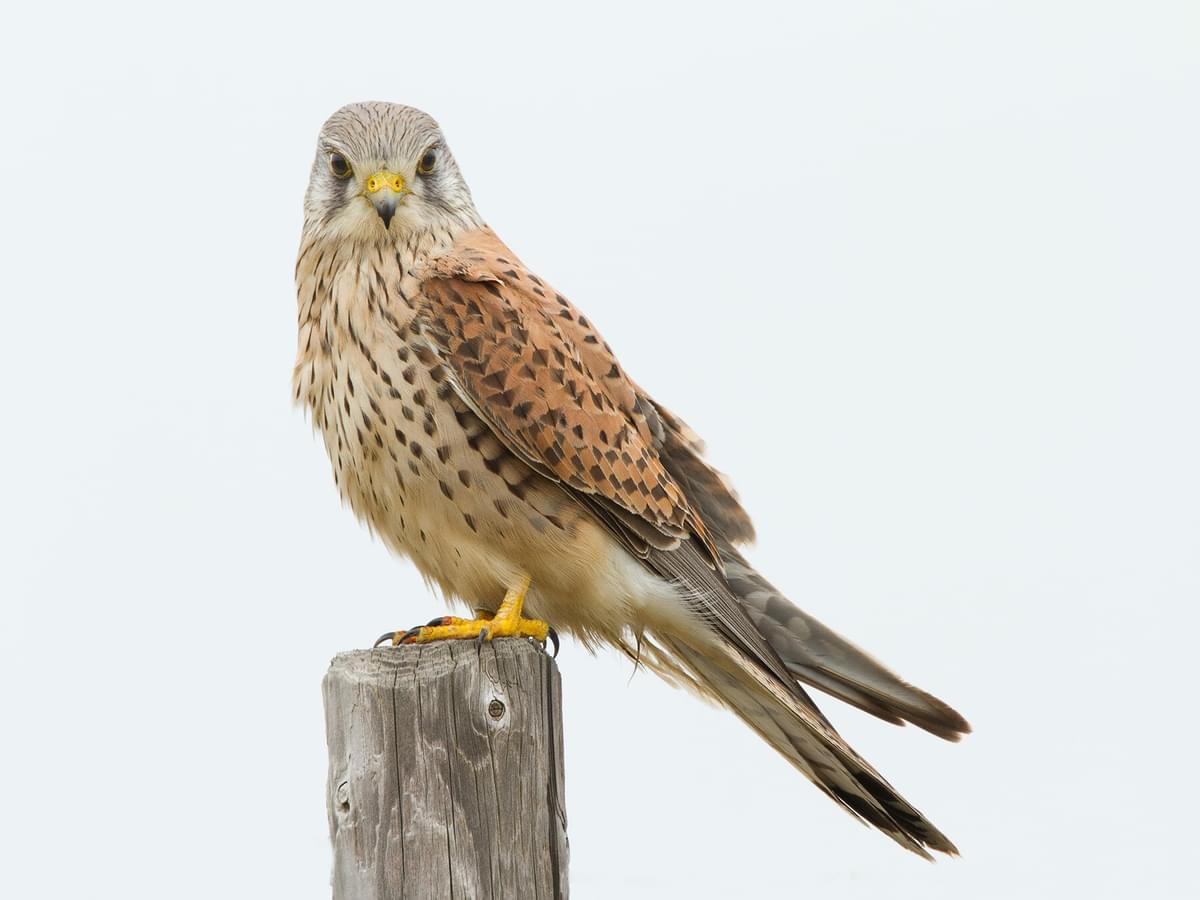
Length
32-39cm
Wingspan
65-82cm
Weight
136-252g
Regional Rarity Score
Ranges from 0 (common) to 100 (extremely rare) in this region
Common kestrels are one of the UK’s most common birds of prey from the Falcon family. Though common throughout much of the country, Common kestrels are more common in rural woodland, farmland and moorland. They’re commonly seen hovering from a height of 20 to 30m before rapidly swooping in to catch their prey.
Appearance
Measuring just 32 to 39cm with wingspans of around 65 to 80cm, Common kestrels are predominantly light-brown with dark spots. Males often have a grey-blue head, but female Kestrels are all usually brown. Their wings and tails are long, but they’re quite compact compared to other birds of prey.
Hobby
Falco subbuteo
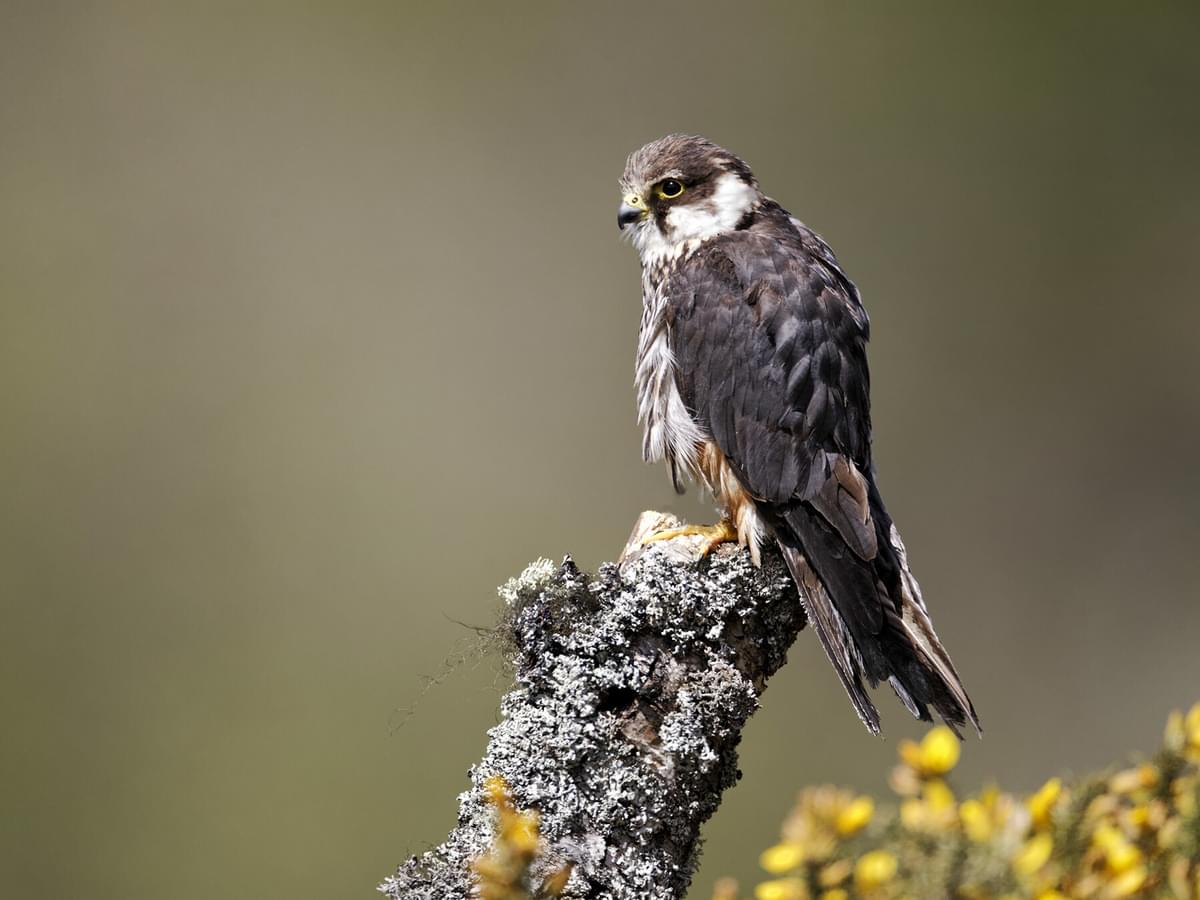
Length
28-35cm
Wingspan
70-84cm
Weight
130-340g
Regional Rarity Score
Ranges from 0 (common) to 100 (extremely rare) in this region
The Hobby, from the Falcon family, is the second smallest bird of prey in the UK. These are summer visitors to the UK, as they usually winter over in Africa. Extremely fast and agile, Hobbies prefer open habitats and consume a large proportion of invertebrates, particularly dragonflies. Though they breed across much of the UK, they’re most common in Wales and English moorlands.
Appearance
A small raptor that measures around 32 to 36cm in length with a wingspan of 75 to 88cm, Hobbies have a streaked white and brown breast with reddish thighs that look like ‘trousers’. Their wings are long and narrow, especially relative to their small size. This enables the Hobby to accelerate rapidly in flight - it’s one of the fastest birds in the UK.
Tawny Owl
Strix aluco
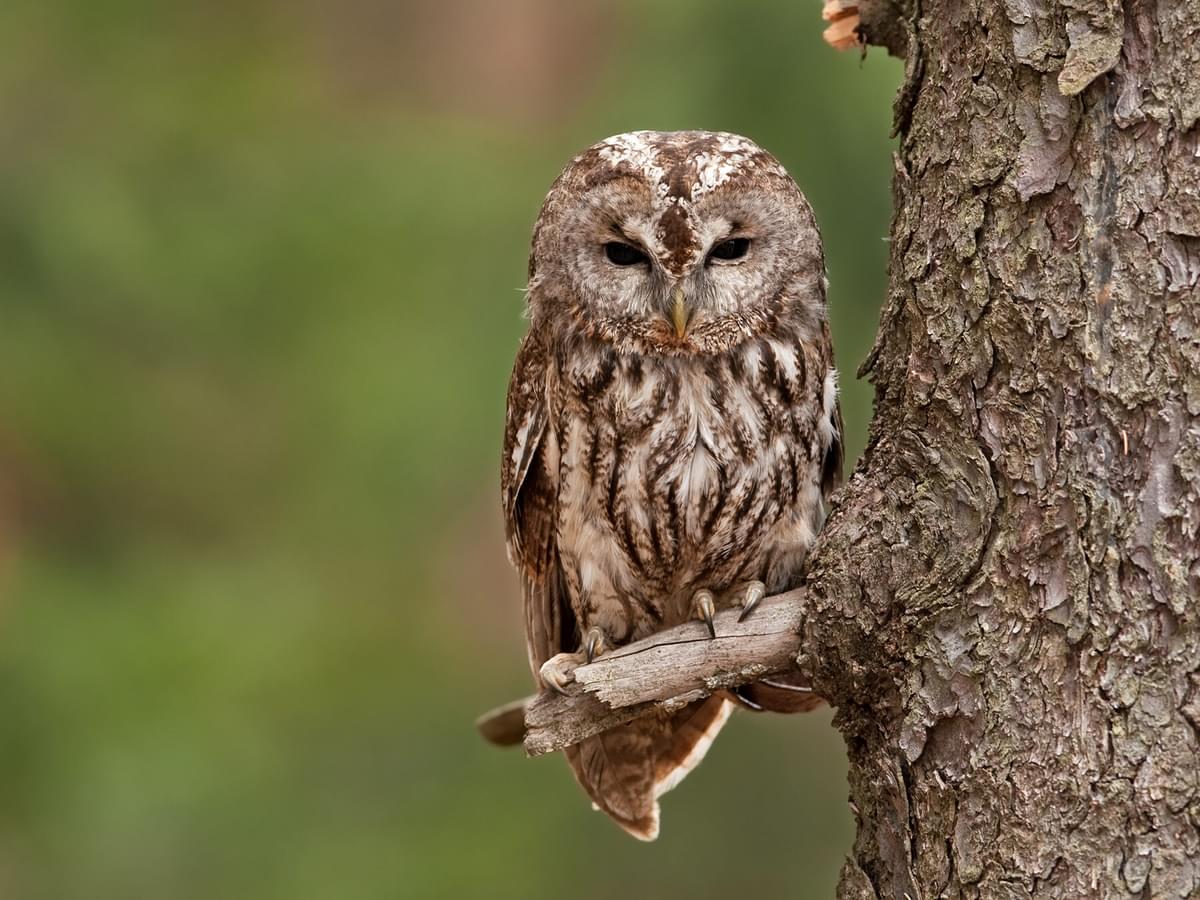
Length
37-43cm
Wingspan
94-104cm
Weight
330-590g
Regional Rarity Score
Ranges from 0 (common) to 100 (extremely rare) in this region
The most common owl in the UK, the Tawny owl, is a dark-brown, well-camouflaged owl. Though widespread throughout much of England, Wales and Scotland (except the Highlands and Scottish islands), Tawny owls are absent from Northern Ireland.
Tawny owls are strictly nocturnal and you’re more likely to hear their characteristic low-pitched "hoot" than see them. Mice, voles and other small mammals are the dietary staple of Tawny owls in the UK and they’re expert nocturnal hunters, swooping and seizing their prey while barely making a sound.
Appearance
Measuring around 36 to 39cm and with a wingspan of 94 to 105cm, Tawny owls are brown and dark brown with pale underparts. Their feathers are soft, fluffy and downy, which helps them fly silently. Their heads are rounded, and they have large, dark eyes. Tawny owls are classically owl-like in appearance.
Barn Owl
Tyto alba
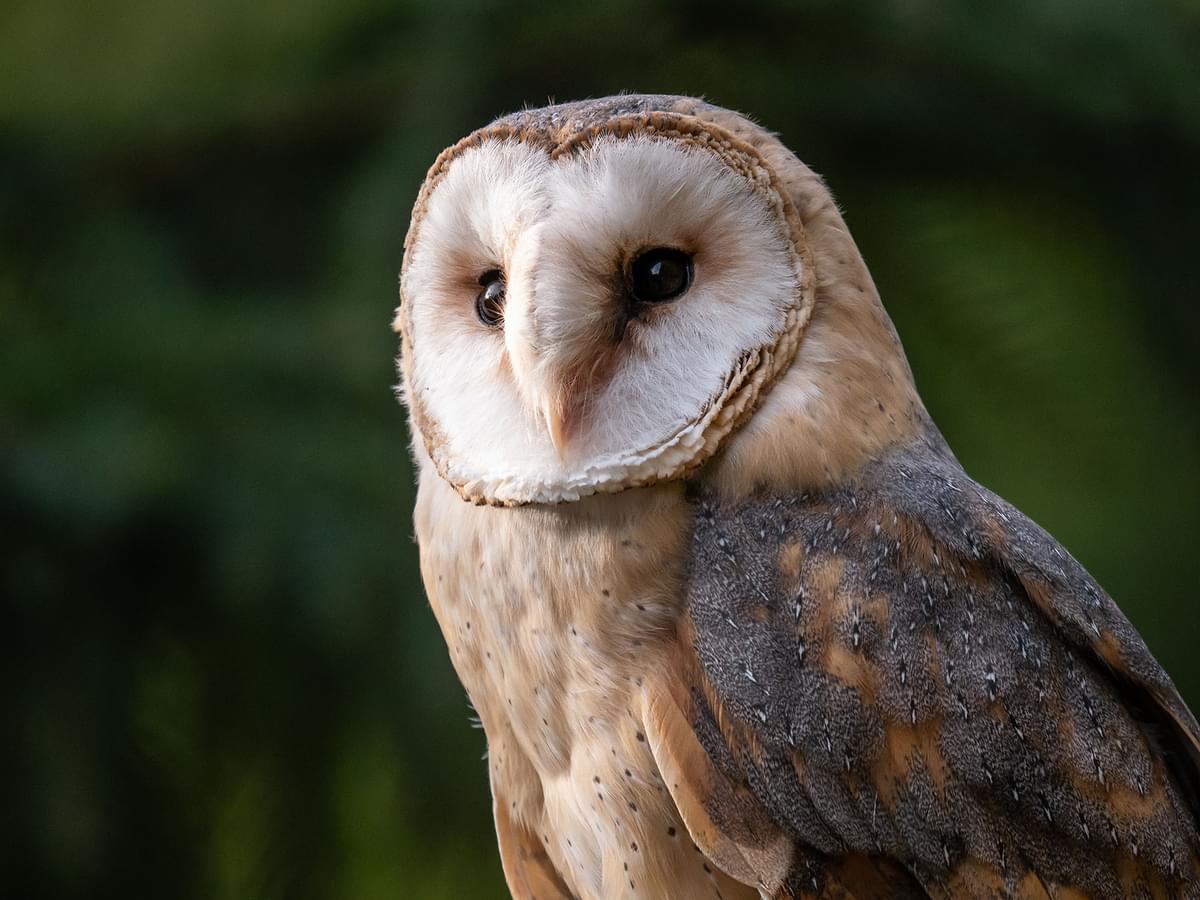
Length
33-39cm
Wingspan
80-95cm
Weight
430-620g
Regional Rarity Score
Ranges from 0 (common) to 100 (extremely rare) in this region
One of the most common and widely distributed owls in the world, the Barn owl is known for its heart-shaped face and sharp, beady eyes. These sedentary birds stay in the UK all year round and can be found everywhere apart from the Scottish Highlands.
Hunting primarily at dusk and dawn, Barn owls are almost silent during flight and have exceptional senses of sight and hearing. They have a piercing shrieking call which landed them the nickname ‘Demon owl’.
Appearance
Measuring around 30 to 40cm long with a wingspan of 80 to 95cm, Barn owls are medium-sized owls with long wings and a heart-shaped face. They’re pale grey/brown with shades of darker grey and hazel across their wings and necks. Wings are generally darker than the body.
Less Common Birds of Prey in the UK
Although some of these birds of prey can still regularly be seen, you're generally less likely to come across than the birds above.
Osprey
Pandion haliaetus
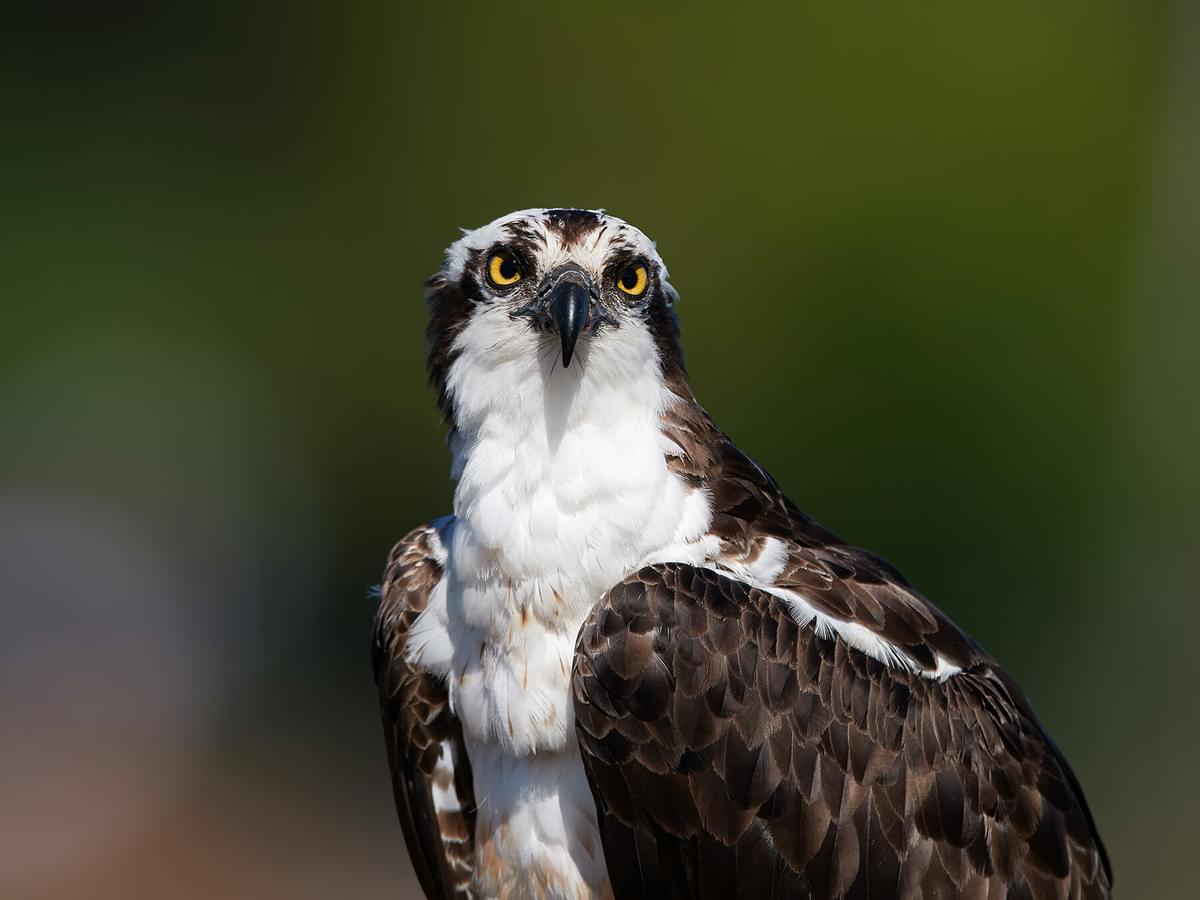
Length
54-58cm
Wingspan
150-180cm
Weight
1.2-2kg
Regional Rarity Score
Ranges from 0 (common) to 100 (extremely rare) in this region
Though they live on practically every continent, Ospreys are rare in the UK. These piscivorous birds feed almost solely on fish which make up 99% of their diets.
Several biological adaptations make it much easier for Ospreys to catch their chosen prey. For example, Ospreys have reversible toes with sharp barbs that enable them to grasp slippery fish from the water.
There are around 250 breeding pairs of Ospreys in the UK, and they live mainly in Scotland and Cumbria. Rutland Water is also a well-known location for Ospreys too.
Appearance
Measuring around 50 to 67cm and with a wingspan of 155 to 180cm, Ospreys are large birds of prey. Their upper parts are brown, but their breasts and underparts are white, or white and brown. They have a dark-brown mask that stripes across the eye.
Golden Eagle
Aquila chrysaetos

Length
66-102cm
Wingspan
180-230cm
Weight
3-6.7kg
Regional Rarity Score
Ranges from 0 (common) to 100 (extremely rare) in this region
The Golden eagle eclipses most raptors in terms of sheer size and weight. Golden eagles live in Scotland, primarily in the Highlands and on the Scottish islands, but there are plans to reintroduce them in Wales and Northern Ireland. In 2016, there were an estimated 500 breeding pairs of Golden eagles in Scotland, and their populations are gradually climbing.
An impressive bird, the Golden eagle hunts medium and large mammals and birds, including rabbits, voles, ptarmigans and sometimes even small or baby deer.
Golden eagles mate for life and often hunt cooperatively in pairs. Though they can swoop from great heights at speeds exceeding 150mph, they prefer to hunt from fairly close to the ground, or even from a treetop perch. Some studies suggest that Golden eagles are faster than the Peregrine falcon, which is widely touted to be the world’s fastest bird and animal.
Appearance
These mighty eagles have wingspans exceeding 2m and are around 75 to 88cm long. Golden eagles are primarily darkish brown, but their neck and nape are more of a copper-gold, hence ‘Golden’ eagle. They have a white stripe across the tail and white patches towards the end of each wing. Their yellow feet are almost completely covered in feathers.
White-tailed Sea-eagle
Haliaeetus albicilla

Length
66-94cm
Wingspan
180-240cm
Weight
3-6.9kg
Regional Rarity Score
Ranges from 0 (common) to 100 (extremely rare) in this region
The second of the two eagles that inhabit the UK. The White-Tailed eagle is one of the largest eagles in the world and is slightly bigger than the Golden eagle.
The White-Tailed eagle was extinct in the UK prior to the 1970s, but was reintroduced to Scotland from Norway. Their numbers are gradually climbing, and they’ve also been reintroduced to the Isle of Wight. These sea-faering eagles prey upon fish, animals and birds.
White-Tailed eagles are uncommon, and you’d be lucky to see one. There are only around 40 breeding pairs in Scotland and fewer in the south of England.
Appearance
Measuring 67 to 100cm in length and with a wingspan of 1.78 to 2.45m, White-Tailed eagles are mostly light to medium-brown with a pale head and broad, ‘fingered’ wings. As their name suggests, they do indeed sport a large white tail which makes them somewhat easy to identify from other similar eagles.
Western Marsh-harrier
Circus aeruginosus
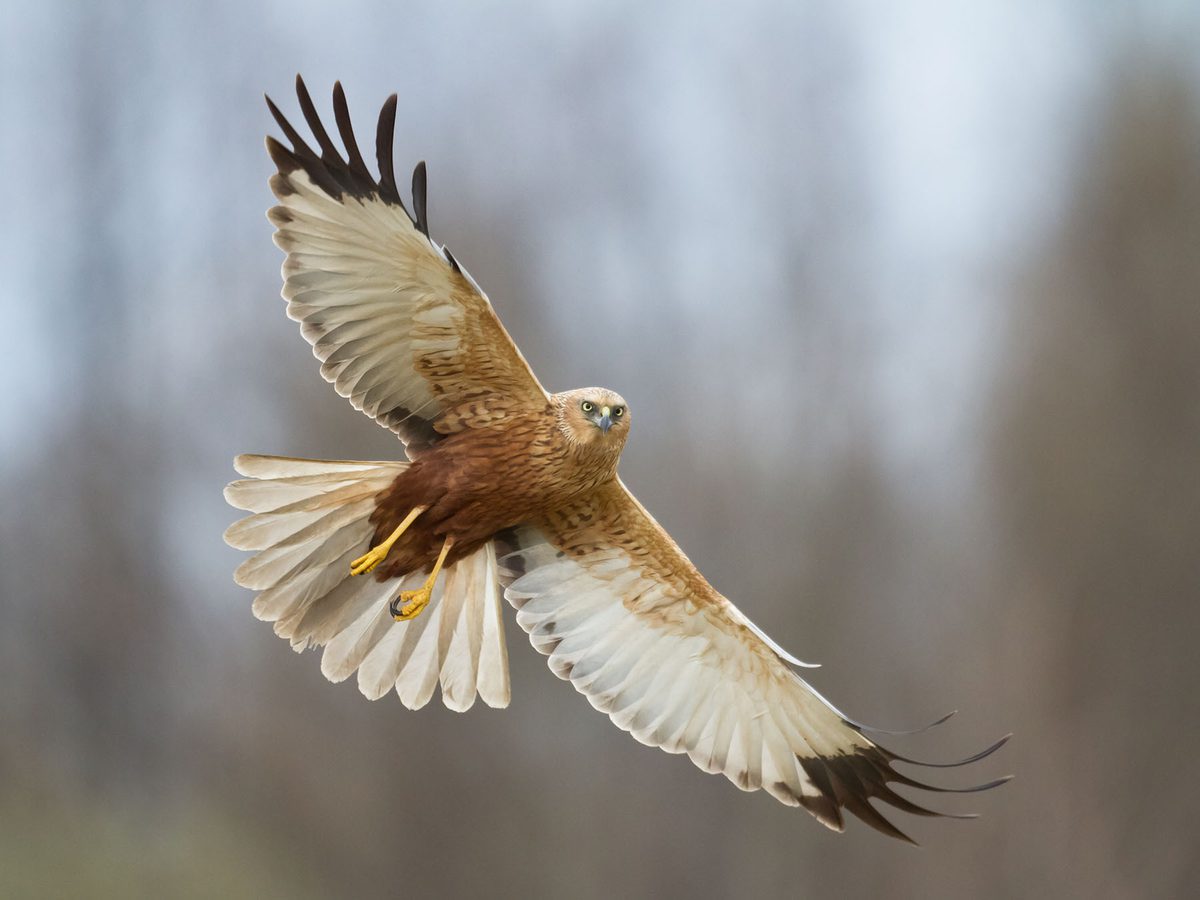
Length
48-56cm
Wingspan
115-130cm
Weight
500-1100g
Regional Rarity Score
Ranges from 0 (common) to 100 (extremely rare) in this region
Marsh harriers are uncommon, with 70% of the UK population living in East Anglia. Once the UK’s least common raptor, their numbers are sharply rising, and there are now over 500 breeding pairs. Marsh harriers are subtle, swift and incisive hunters that target an array of small mammals, small and medium-sized birds, including moorhens, and amphibians like frogs.
Appearance
Measuring 48 to 56cm and with a wingspan of 115 to 130cm, Marsh harriers are compact raptors, though larger than other harriers. They’re primarily medium and dark-brown with a pale-brown head and greyish underparts.
Hen Harrier
Circus cyaneus

Length
41-52cm
Wingspan
97-122cm
Weight
300-750g
Regional Rarity Score
Ranges from 0 (common) to 100 (extremely rare) in this region
The Hen harrier is the UK’s most heavily persecuted bird because of its tendency to predate fowl, hence the name ‘Hen’ harrier. It’s been saved from near-extinction but remains confined to isolated areas of Scotland, particularly the Scottish islands, the Isle of Man and North Wales.
Appearance
Hen harriers are around 42 to 46cm long with a wingspan of approximately 1.0 to 1.1m. They’re mostly blue-grey with paler undersides. Hen harriers are slimmer than most harriers and have slim wings. The females are darker with a banded tail.
Peregrine Falcon
Falco peregrinus
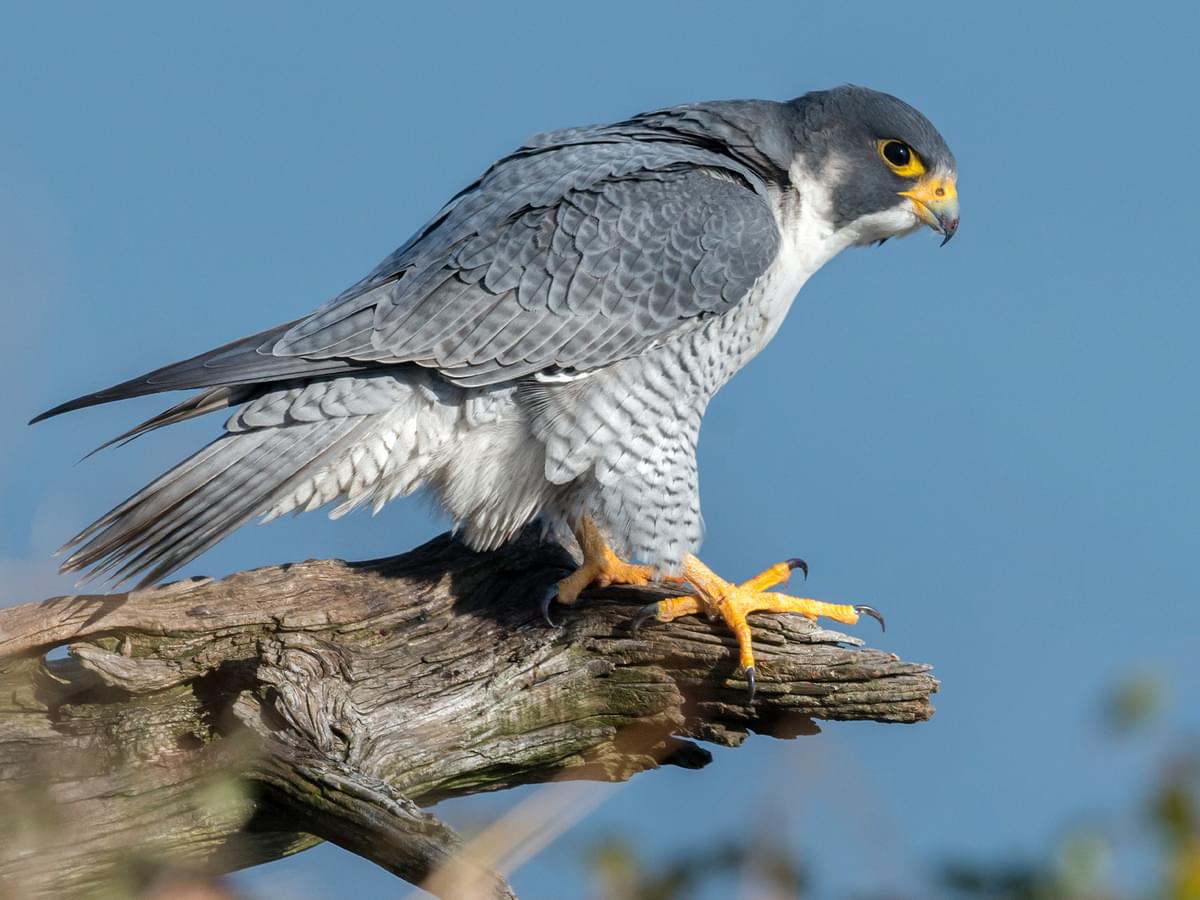
Length
34-58cm
Wingspan
74-120cm
Weight
330-1500g
Regional Rarity Score
Ranges from 0 (common) to 100 (extremely rare) in this region
Widely regarded as the fastest animal on the planet, the Peregrine falcon can dive at an incredible speed of 200mph. Its compact, slim and aerodynamic body has inspired aircraft design, and is especially impressive for allowing the bird to control flight in high winds and turbulent conditions.
Peregrine falcons are found primarily in Wales, southern Scotland and northwest England, but their numbers are slowly climbing throughout much of the UK. Feeding primarily on airborne birds such as pigeons and doves, songbirds, waterfowl and even corvids, the Peregrine falcon is one of the world's most spectacular and efficient aerial hunters.
Appearance
The Peregrine falcon measures 35 to 58cm in length and has a wingspan of 74 to 120cm. The female is notably larger than the male and has a more diverse diet as a result. They have a blueish to slate-grey back with mottled white and light-brown underparts. Their short beaks feature an underslung ‘moustache’, which is a small tuft of feathers.
Merlin
Falco columbarius
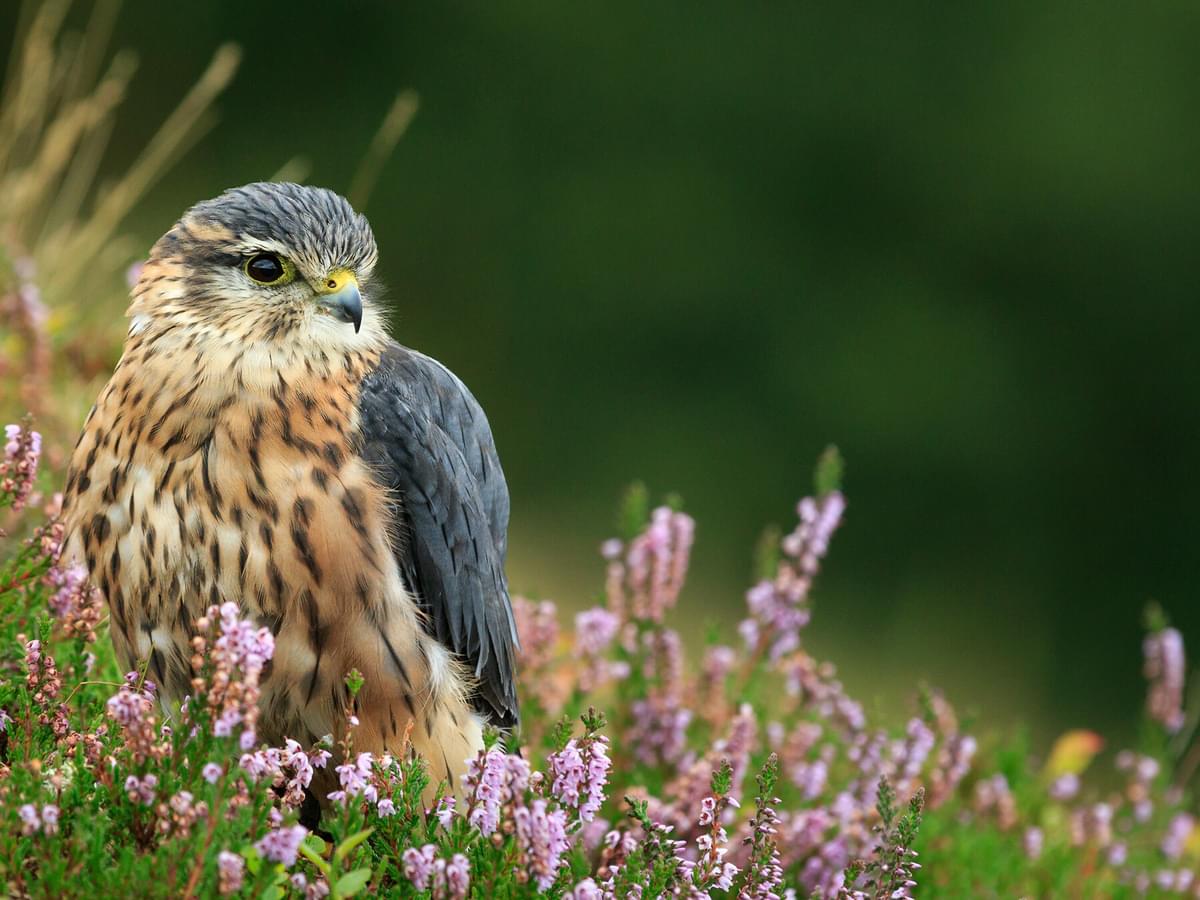
Length
24-33cm
Wingspan
50-62cm
Weight
125-300g
Regional Rarity Score
Ranges from 0 (common) to 100 (extremely rare) in this region
The Merlin is a small but deadly bird from the Falcon family. It’s the UK's smallest bird of prey, and is the smallest falcon in the Northern Hemisphere. Found primarily in Scotland, Wales, and northwest England, particularly the Peak District, the UK Merlin population increases considerably in winter as they migrate here from northern Europe and Scandinavia.
The Merlin preys upon many small birds such as tits and finches, and mammals like voles and mice. It can take down prey considerably heavier than itself.
Appearance
The Merlin is barely bigger than a Blackbird, measuring around 24 to 35cm long with a wingspan of 50 to 73cm. Merlins are primarily blue/grey to black but have paler underparts. Their wings are broad, and they have a long square tail.
Short-eared Owl
Asio flammeus

Length
34-43cm
Wingspan
85-110cm
Weight
206-475g
Regional Rarity Score
Ranges from 0 (common) to 100 (extremely rare) in this region
Short-eared owls are one of the UK’s less common owls, primarily inhabiting Scotland, northern England and Northern Ireland. Resident numbers increase during the winter as birds from Russia and Scandinavia head to winter in the UK.
They mainly hunt during the day, and they’re often spotted flying stealthily over open countryside. There are just 2,000 breeding pairs of Short-eared owls in the UK.
Appearance
Short-eared owls are relatively small, measuring 34 to 42cm long and have a wingspan of around 90 to 105cm. The Short-eared owl has short, stubby ears, but these are not usually obvious during flight. They’re predominantly dark brown with paler undersides.
Long-eared Owl
Asio otus

Length
35-40cm
Wingspan
90-100cm
Weight
220-435g
Regional Rarity Score
Ranges from 0 (common) to 100 (extremely rare) in this region
Long-eared owls are thought to be relatively abundant across the UK, but estimating their population is a challenge due to their highly secretive nature. In contrast to the Short-eared owl, Long-eared owls are strictly nocturnal and rarely make themselves seen. There are probably a similar number of Long-eared owls in the UK as Short-eared owls.
Appearance
Long-eared owls are similar in size to Short-eared owls, measuring around 35 to 37cm long with a wingspan of 92 to 95cm. However, their long ears are their most striking feature - these are called ear tufts and are shared by many owls, most prolifically the Great Horned owl. Long-eared owls are dark and light brown with paler undersides and have striking yellow eyes.
Little Owl
Athene noctua
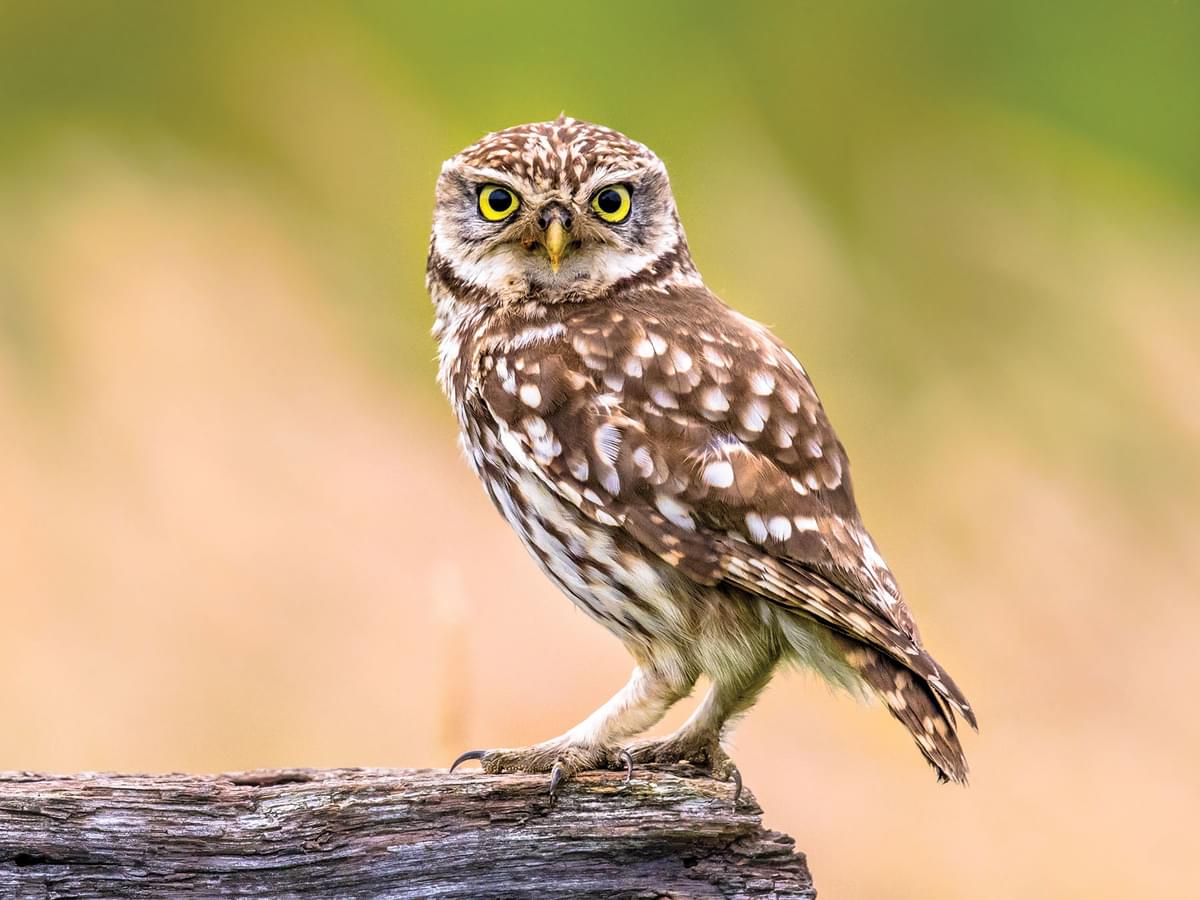
Length
21-23cm
Wingspan
54-58cm
Weight
140-200g
Regional Rarity Score
Ranges from 0 (common) to 100 (extremely rare) in this region
The Little owl was introduced to the UK in the 18th century and is one of the world’s smallest owls. Some 40 Little owls were released between 1874 and 1880, and their numbers have slowly but surely increased.
They’re not much larger than a thrush, but their chunky form-factor makes them unmistakably owlish. Though concentrated in west Wales and East Anglia, there are an estimated 5,000 or so breeding pairs of Little owls littered across isolated areas in the UK.
Appearance
Little owls are small, measuring around 20 to 22cm with a wingspan of 55cm or so. They’re typically owlish in shape and colour, with dark and light mottled plumage. Little owls have large heads for their size and white ‘eyebrows’.
European Honey-buzzard
Pernis apivorus
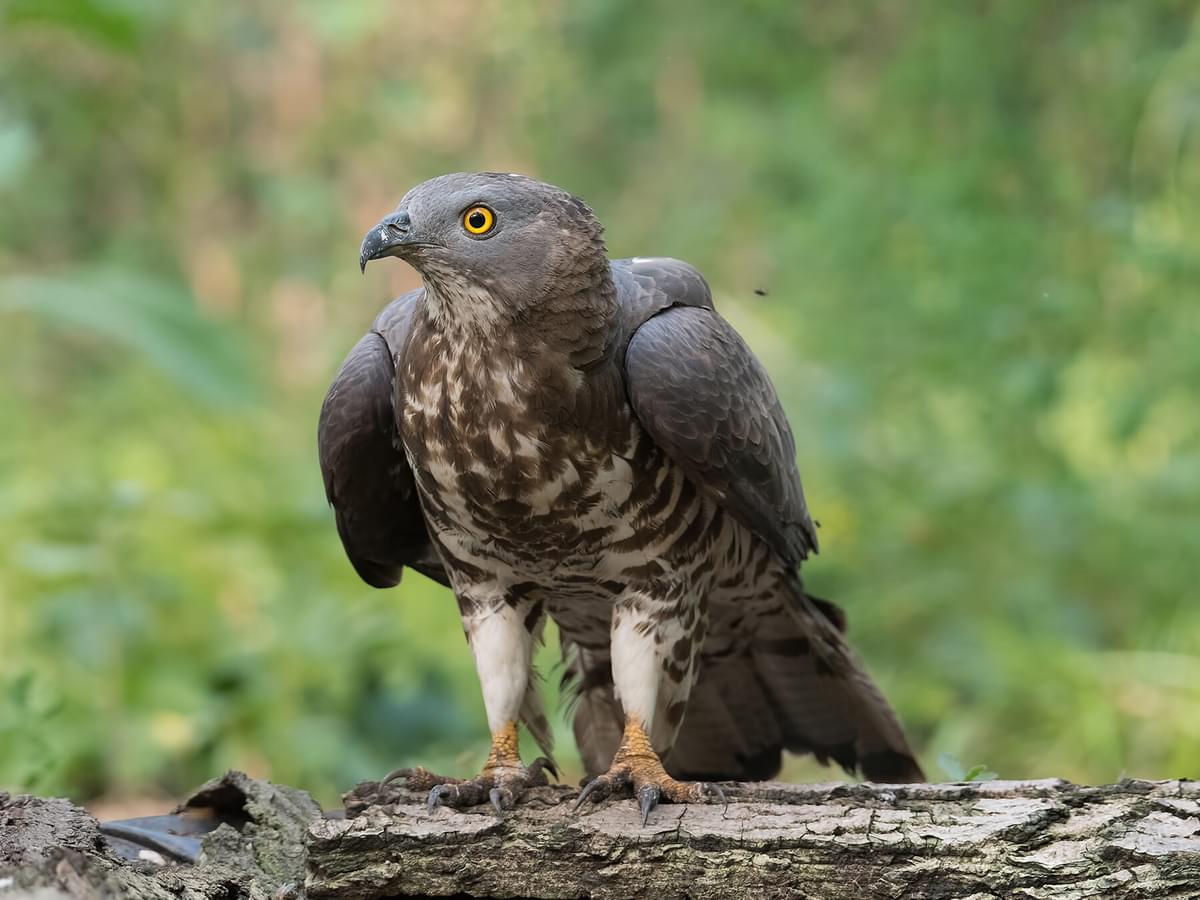
Length
52-60cm
Wingspan
135-150cm
Weight
600-1000g
Regional Rarity Score
Ranges from 0 (common) to 100 (extremely rare) in this region
There is a lesser-known but perhaps more fascinating buzzard in the UK besides the Common buzzard - the Honey buzzard. The Honey buzzard is peculiar amongst all raptors as it’s a specialist feeder that consumes the grubs and larvae of bees and wasps. It does also hunt small animal and birds.
The UK’s Honey buzzard population is small - around just 100 pairs - but they can be found in Scotland, Wales and the north and south of England.
Appearance
Honey buzzards look like Common buzzards, but have longer wings (around 155cm), a longer tail and a much slimmer neck.
Northern Goshawk
Accipiter gentilis
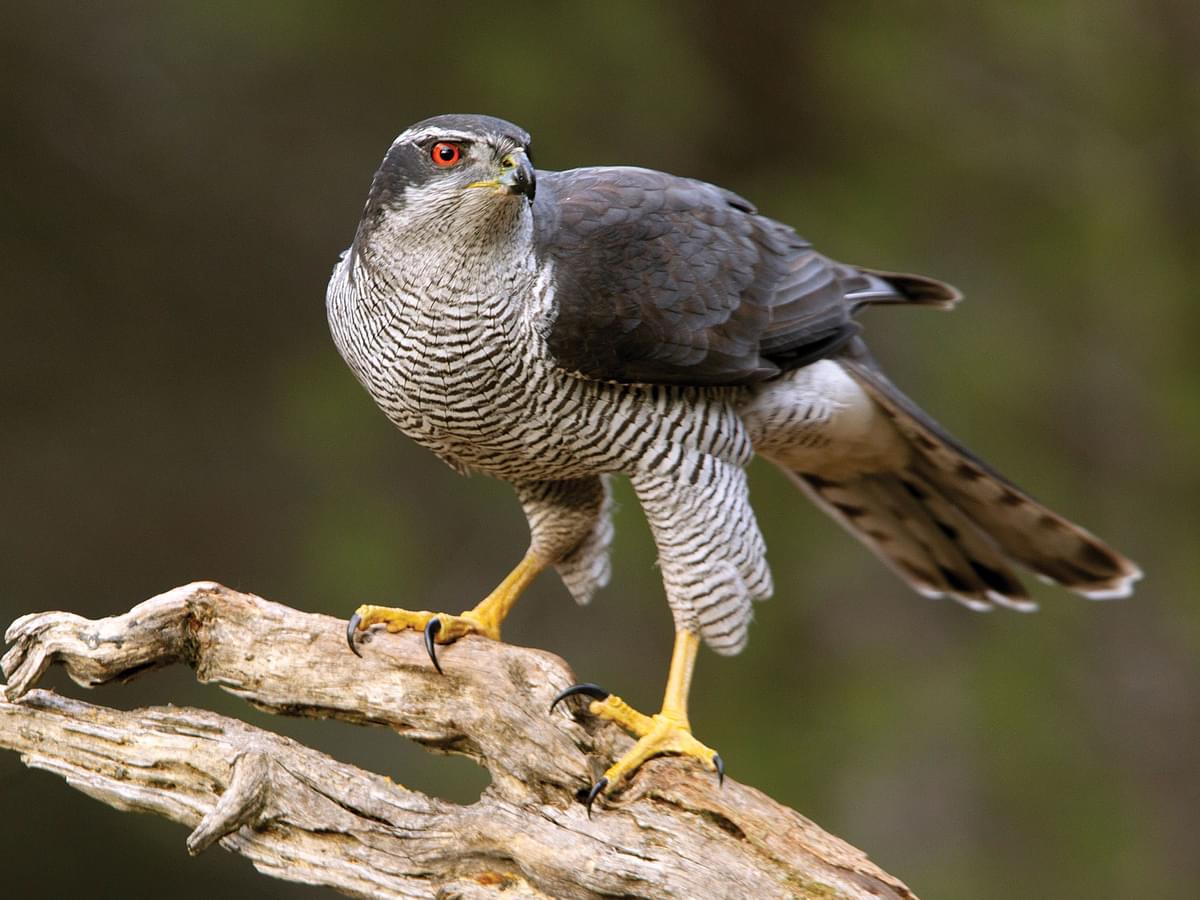
Length
46-61cm
Wingspan
98-127cm
Weight
630-2000g
Regional Rarity Score
Ranges from 0 (common) to 100 (extremely rare) in this region
The goshawk is a large member of the hawk family and can be comparable size-wise to a buzzard, although goshawks are ever so slightly smaller.
There is only a small breeding population of goshawks here in the UK, thought to be anywhere from 280 to 430 pairs, so they're quite uncommon to see.
Goshawks can be found scattered across parts of Scotland, England (mainly Northern parts) and in Wales.
Appearance
They have white eyebrows, red eyes and a relatively menacing expression when you see them up close. The large wings mean they are capable of reaching high speeds, which is useful when hunting. Goshawks are effectively able to catch prey in flight due to their long talons and legs.
Females are generally much larger than the males.
Rough-legged Hawk
Buteo lagopus
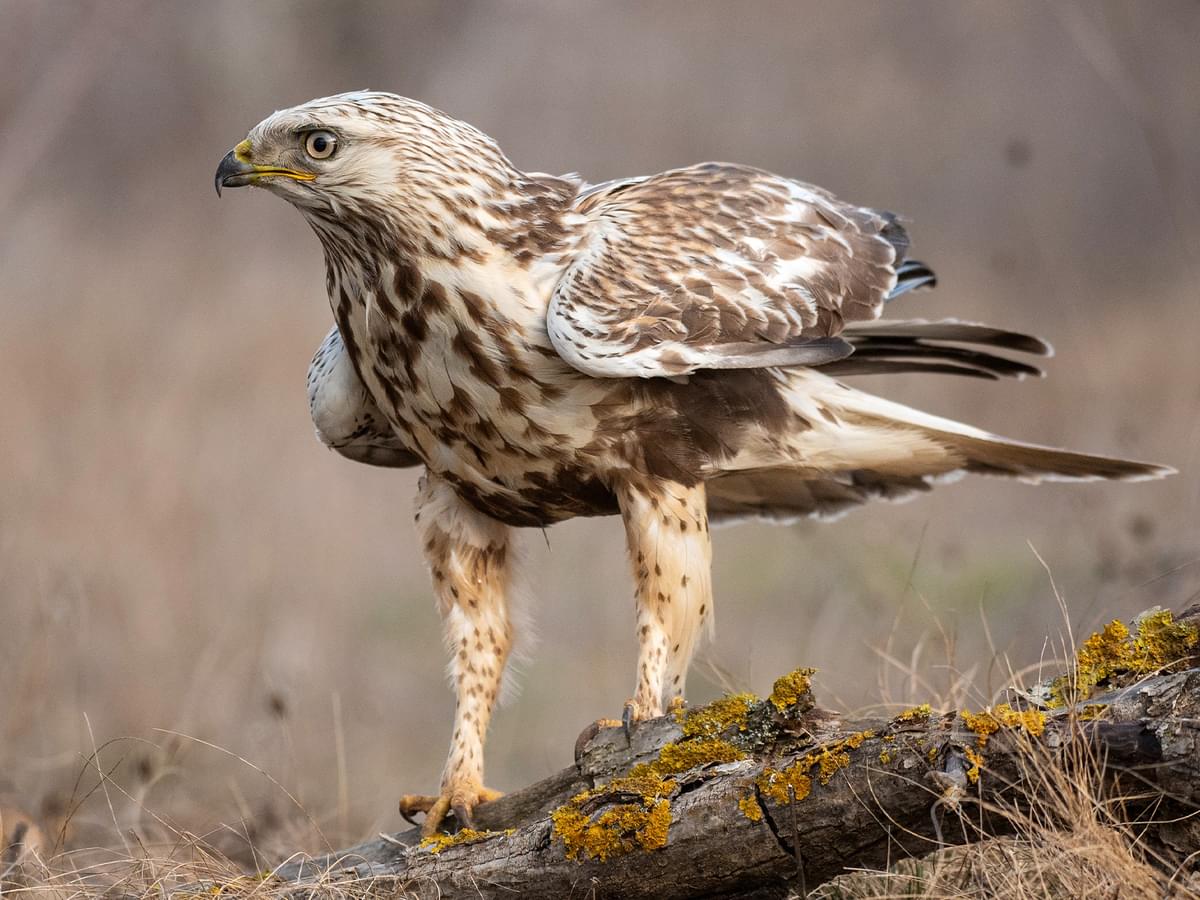
Length
46-59cm
Wingspan
120-153cm
Weight
715-1400g
Regional Rarity Score
Ranges from 0 (common) to 100 (extremely rare) in this region
Rough-legged Buzzards are pretty rare to spot across the UK, as we usually only get a handful of these birds visit during the winter and they're not resident, like most of the birds of prey on this list.
They are fairly similar in size and appearance to common buzzards, however, when spotted in flight, you can often notice that, unlike common buzzards, they'll 'hang' in the sky more, almost in a hovering fashion.
Rough-legged buzzards have legs with a thick covering of feathers, which is where they gained their name from. The wings are also generally longer than the common buzzard, and the head is much paler.
Montagu's Harrier
Circus pygargus

Length
43-47cm
Wingspan
108-120cm
Weight
230-445g
Regional Rarity Score
Ranges from 0 (common) to 100 (extremely rare) in this region
If you happen to spot a Montagu's Harrier in the UK, you should certainly feel very lucky! Not only are these magnificent birds, but it's estimated that we only get around 5 breeding pairs to visit each year.
Thes best time to see these birds are usually between May and September, usually on both the south and eastern coasts of England.
After breeding, Montagu's Harrier set off on migration to Africa for the winter.
What are birds of prey?
Birds of prey, also called raptors, are carnivorous birds that hunt and kill vertebrate prey such as birds, mammals, reptiles, fish and amphibians. Many birds of prey do also feed on invertebrates such as arthropods and insects, but virtually every bird of prey in the world eats nearly 100% meat.
As such, birds of prey are typically fast and strong and are equipped with superior senses of sight and hearing. In addition, they have strong, sharp talons and bills that are specially designed for meat. Some birds of prey have picked up special adaptations, such as owls’ ability to fly near-silently so as not to disturb their prey in the dead of night.
Though it’s tempting to focus on large birds of prey such as eagles, they come in many different shapes and sizes, ranging from the Andean condor, with a wingspan of some 3.3m, to the Black-thighed falconet with a wingspan of just 30cm.
What is the most common bird of prey in the UK?
The most common bird of prey in the UK is the Common buzzard, with over 70,000 to 100,000 breeding across virtually every region of the UK.
Populations of birds of prey vary hugely across the UK; Sparrowhawks, Kestrels and Red Kites are also considered common.
What is the largest bird of prey in the UK?
The largest bird of prey in the UK is the White-Tailed eagle, followed closely by the Golden eagle.
White-Tailed eagles measure around 67 to 100cm in length and have a wingspan of 1.78 to 2.45m - they’re the fourth largest eagle in the world. The largest common bird of prey in the UK is the Red Kite, with a wingspan of some 175cm.
What is the second largest bird of prey in the UK?
Coming in at a close second, the Golden eagle is the second largest bird of prey that can be found in the UK. Golden eagles can currently be spotted mainly in the Scottish Highlands, although there are plans to try and reintroduce them to parts of Northern Ireland and Snowdonia in Wales.
What is the smallest bird of prey in the UK?
The Merlin is widely touted as the UK’s smallest bird of prey, but the Little owl is an often-overlooked contender.
The Merlin measures 24 to 35cm long with a wingspan of 50 to 73cm, whereas the Little owl measures 20 to 22cm with a wingspan of 55cm. So it may well be that the Merlin is not the smallest bird of prey in the UK after all. However, it’s worth noting that the Little owl was introduced in the UK in the 18th century, whereas the Merlin is an endemic resident.
How many birds of prey are there in the UK?
There are around 15 species of birds of prey in the UK, but it’s tough to nail down an exact figure as some species arrive here during winter from Scandinavia and North Europe, whereas others leave to southern Europe, Africa and Asia.
What is the fastest bird of prey in England?
The Peregrine Falcon is the fastest bird of prey in the UK, as well as the fastest in the world. These impressive birds can reach speeds of up to 200 miles per hour whilst diving for prey.
Are birds of prey under threat?
The numbers of birds of prey in the UK are higher than they have been in around a century. In the 18th and 19th centuries particularly, birds of prey were heavily persecuted. This steadily changed around the 19th century.
Then, widespread herbicide use caused another decline in birds of prey numbers in the late 20th century. Once destructive herbicides were outlawed, raptor numbers in the UK have climbed. Reintroduction and conservation projects have also helped swell numbers. However, this is a constant work in progress and many birds of prey still face threats today.
What is the big dark brown bird of prey in the UK?
Buzzards are the most likely suspect for being the large dark brown birds of prey in the UK. The plumage of Buzzards can be pretty variable, with some dark morphs, intermediate and some lighter plumaged birds.
